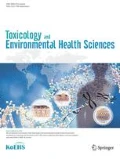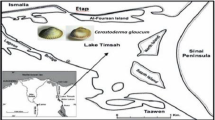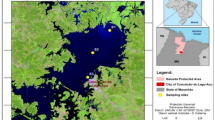Abstract
Objective
Bisphenol A (BPA), a commonly occurring industrial chemical that is present in polycarbonate plastics and epoxy resins is mechanistically shown to affect various bodily functions of organisms. However, very limited studies have been done on the histological effects of BPA on bivalves. In this study, the toxicity of BPA was analyzed through its histological effects on the gills, digestive glands and adductor muscles of Corbicula fluminea, a freshwater bivalve.
Methods
Forty C. fluminea were exposed to set-ups with 1 µg/L, 2 µg/L and 3 µg/L of BPA for twenty-one days. Afterwhich, histolopathological analysis were done in the adductor muscles, digestive glands and gills of the clam. Histological alterations such as vacuolations, necrosis, lamellar deformation, hyperplasia, loss of epithelium, necrosis, tubular alteration, neoplasia, hemocyte infiltration, hypertrophy and pyknosis were observed and percent histological aberrations were determined per organ.
Results
Results showed that there was a significant difference in the histological alterations observed between the tissues of exposed and unexposed clams. Moreover, varying concentrations of BPA rendered differential degree of histological damage on the soft tissues of the clam. The digestive gland was the most affected tissues followed by the gill then the adductor muscles.
Conclusion
BPA were found to be toxic to C. fluminea as evidenced by histology. Moreover, the differential histological responses of the tissues of C. fluminea in different concentrations of BPA proves that they are good indicators of environmental stressors such as BPA.
Similar content being viewed by others
References
Flint, S., Markle, T., Thompsin, S. & Wallace, E. Bisphenol A exposure, effects and policy: A wildlife perspective — a Review. J. of Environ. Mngt. 104, 19–34 (2012).
Stahlhut, R. W., Welshons, W. V. & Swan, S. H. Bisphenol-A data in NHANES suggest longer than expected half-life, substantial nonfood exposure, or both. Environ. Health Perspect. 117, 784–789 (2009).
Oehlmann, J., Schulte-Oehlmann, U., Tillmann, M. & Markert, B. Effects of endocrine disruptors on proso-branch snails (Mollusca: Gastropoda) in the laboratory. Part I: Bisphenol A and octylphenol as xeno-estrogens. Ecotoxicol. 9, 383–397 (2000).
Crain, D. A. et al. An ecological assessment of bisphenol-A: evidence from comparative biology. Reprod. Toxicol. 24, 225–239 (2007).
Oehlmann, J. et al. A critical analysis of the biological impacts of plasticizers on wildlife. Phil. Trans. R. Soc. B 364, 2047–2062 (2009).
Ike, M., Jin, C. S. & Fujita, M. Biodegradation of bisphenol A in aquatic environment. Water Sci. Technol. 42, 31–38 (2000).
Kang, J. H., Aasi, D. & Katayama, Y. Bisphenol a in the aquatic environment and its endocrine-disruptive effects on aquatic organisms. Crit. Rev. Toxicol. 37, 607–625 (2007).
Lehmann, D. W., Levine, J. F. & Law, J. M. Polychlorinated biphenyl exposure causes gonadal atrophy and oxidative stress in Corbicula fluminea clams. Toxic. Path. 35, 356–365 (2007).
Oliveira, L. F., Silva, S. M. C. P. & Martinez, C. Assessment of domestic landfill leachate toxicity to the Asian clam Corbicula fluminea via biomarkers. Ecotoxicol. Environ. Saf. 103, 17–23 (2014).
Santos, K. C. & Martinez, C. B. R. Genotoxic and biochemical effects of atrazine and Roundups, alone and in combination, on the Asian clam Corbicula fluminea. Ecotoxicol. Environ. Saf. 100, 7–14 (2014).
Mantecca, P., Vailati, G. & Bacchetta, R. Histological changes and Micronucleus induction in the Zebra mussel Dreissena polymorpha afterparaquat exposure. Histol. Histopathol. 21, 829–840 (2006).
Beltran, K. S. & Pocsidio, G. N. Acetylcholinesterase activity in Corbicula fluminea Mull., as a biomarker of organophosphate pesticide pollution in Pinacanauan River, Philippines. Environ. Monit. Assess. 165, 331–340 (2010).
Britton, J. C. & Morton, B. in A dissection guide, field and laboratory manual for the introduced bivalve Corbicula fluminea. Malacologia Rev. (Niwot, Colorado, U.S.A. 1982).
McMahon, R. F. in Ecology and classification of North American freshwater invertebrates (eds Thorp, J. H., Covich, A. P.) 331–430 2nd Edn. (Academic Press, San Diego, 2001).
Ruppert, E. E., Fox, R. S. & Barnes R. B. in Invertebrate Zoology, A functional evolutionary Approach 7th Edn. (Brooks Cole Thomson, Belmont California, 2004).
Graney, R. L., Cherry, D. S. & Cairns, J. Heavy metal indicator potential of the Asiatic clam Corbicula fluminea in aquatic ecosystems: An overview. Hydrobiologia 102, 81–88 (1983).
Doherty, F. G. The Asiatic clam, Corbicula spp as a biological monitor in freshwater environments. Environ. Monit. Assess. 15, 143–181 (1990).
Colombo, J. C., Bilos, C., Campanaho, M., Presa, M. J. R. & Catoggio, J. A. Bioaccumulation of polychlorinated-biphenys and chlorinated pesticides by the Asiatic Clam Corbicula fluminea—its use as sentinelorganism in the Rio-De-La-Plata Estuary, Argentina. Environ. Sci. Technol. 29, 914–927 (1995).
Labrot, F., Narbonne, J. F., Ville, P., Saint Denis, M. & Ribera, D. Acute toxicity, toxicokinetics, and tissue target of lead and uranium in the clam Corbicula fluminea and the worm Eisenia fetida: comparison with the fish Bradydanio rerio. Arch. Environ. Contam. Toxicol. 36, 167–178 (1999).
Fournier, E., Adam, C., Massabuau, J. C. & Garnier-La-place, J. Bioaccumulation of waterborne selenium in the Asiatic clam Corbicula fluminea: influence of feeding induced ventilatory activity and seleniumspecies. Aquat. Toxicol. 72, 251–260 (2005).
Way, C. M., Hornback, D. J., Miller-War, C. A., Payne, B. S. & Miller, A. C. Dynamics of filter feeding in Corbicula flumnea (Bivalvia: Corbiculidae). Can. J. Zool. 68, 115–120 (1990).
Bassack, S. B., Oneto, M. L., Verrengia-Guerrero, N. R. & Kesten, E. M. Accumulation and elimination of pentachlorophenol in the freshwater bivalve Corbicula fluminea. Bull. Environ. Contam. Toxicol. 58, 497–503 (1997).
Baudrimont, M., Lemaire-Gony, S, Ribeyre, F., Metivaud, J. & Boudou, A. Seasonal variations of metallothionine concentrations in the Asiatic clam (Corbicula fluminea). Comp. Biochem. Physiol. C 118, 361–367 (1997).
Inza, B., Ribeyre, F., Maury-Brachet, R. & Boudou, A. Tissue distribution of inorganic mercury, methyl-mercury and cadmium in the Asiatic clam (Corbicula fluminea) in relation to the contamination levels of the water columnand sediment. Chemosphere 35, 2817–2836 (1997).
Narbonne, J. F., Djomo, J. E., Ribera, D., Ferrier, V. & Garrigues, P. Accumulation kinetics of polycyclic aromatic hydrocarbon adsorbed to sediment by the mollusk Corbicula fluminea. Ecotoxicol. Environ. Saf. 42, 1–8 (1999).
Tran, D., Boudou, A. & Massabuau, J. C. How water oxygenation levels influences cadmium accumulation pattern in Asiatic clam Corbicula fluminea: a laboratory and field study. Environ. Toxicol. Chem. 20, 2073–2080 (2001).
Cataldo, D. H., Boltovskoy, D., Stripeikis, J. & Pose, M. Condition index and growth rates of field caged Corbicula fluminea (Bivalvia) as biomarkers of pollution gradients in the Paraná River delta (Argentina). Aquat. Ecosyst. Health Manage. 4, 187–201 (2001).
Achard, M., Baudrimont, M., Boudou, A. & Bourdineaud, J. P. Induction of multixenobiotic resistance protein (MXR) in the Asiatic clam Corbicula fluminea after heavy metals exposure. Aquat. Toxicol. 67, 347–357 (2004).
Sousa, R., Antunes, C. & Guilhermino, L. Ecology of the invasive Asian clam Corbicula fluminea in aquatic ecosystems: An overview. Int. J. Limnol. 44, 85–94 (2008).
Hatel, A. et al. Adverse effects of Bisphenol A on reproductive physiology in male goldfish at environmentally relevant concentrations. Ecotoxicol. Environ. Saf. 76, 56–99 (2012).
Yang, Y., Kim, S., Hong, Y., Ahn, J. & Park, M. Environmentally relevant levels of Bisphenol A may accelerate the development of type II diabetes mellitus in adolescent Otsuka Long Evans Tokushima fatty rats. Toxicol Environ. Health. Sci. 6, 41–47 (2014).
Arriola, F. J. & Villaluz, D. K. Snail fishing and duck raising in Laguna de Bay, Luzon. Phil. J. Scie. 69, 173–187 (1939).
Iritani, N., Fukuda, E. & Inoguchi, K. Effect of feeding shellfish Corbicula fluminea on lipid metabolism in rat. Artherosclerosis 34, 41–48 (1979).
Halarnkar, P. P., Chambers, J. D., Wakayama, E. J. & Bloomquist, G. J. Vitamin B12 levels and proprionate metabolism in selected non-insect arthropods and other invertebrates. Comp. Biochem. Physiol. B 88, 869–873 (1987).
Hayashi, O., Kameshiro, M., Masuda, M. & Satoh, K. Bioaccumulation and metabolism of [14C] bisphenol a in the brackish water bivalve Corbicula japonica. Biosci. Biotechnol. Biochem. 72, 3219–3224 (2008).
Kanapala, V. & Arasada, S. P. Histopathological effect of paraquat (gramoxene) on the digestive gland of fresh-water snail Lymnaea luteola (Lamarck: 1799) (mollusca: gastropoda). Int. J. Scien. Res. Environ. Sci. 1, 224–230 (2013).
Costa, P. M., Carreira, S., Costa, M. H. & Caeiro, S. Development of histopathological indices in a commercial marine bivalve (Ruditapes decussatus) to determine environmental quality. Aquat. Toxicol. 126, 442–454 (2013).
Ziegler, U. & Groscurth, P. Morphological features of cell death. Physiology 19, 124–128 (2004).
Goss, R. J. Hypertrophy versus hyperplasia. Science 153, 1615–1620 (1966).
Zong, W. & Thompson, C. B. Necrotic death as a cell fate. Genes Dev. 20, 1–15 (2006).
Leonard, J. A., Cope, W. G., Barnhart, M. C. & Bringolf, R. B. Metabolomic, behavioral, and reproductive effects of the synthetic estrogen 17 α-ethinylestradiol on the unionid mussel Lampsilis fasciola. Aquat. Toxicol. 150, 103–116 (2014).
Payan, P. G., Stecco, A., Stern, R. & Stecco, C. Painful connections: Densification versus fibrosis of fascia. Curr. Pain Headache Rep. 18, 441 (2014).
Kumar, S., Pandey, R. K. & Das, V. K. Dimethoate alters respiratory rate and gill histopathology in freshwater mussel Lamellidens marginalis (Lamarck). J. Appl. Biosci. 38, 154–158 (2012).
Abdel-Nabi, I. M., El-Shenawy, N. S., Taha, I. A. & Moawad, T. I. Oxidative stress biomarkers and bioconcentration of Reldan and Roundup by the edible clam, Ruditapes decussates. Curr. Zool. 53, 910–920 (2007).
El-Shenawy, N. S. et al. Histopathologic biomarker response of clam, Ruditapes decussates, to organophosphorous pesticides Reldan and Roundup: A Laboratory Study. Ocean Sci. J. 44, 27–34 (2009).
Schmitt, P. et al. The antimicrobial defense of the pacific oyster, Crassostrea gigas. How diversity may compensate for scarcity in the regulation of resident/pathogenic microflora. Front. Microbiol. 3, 160 (2012).
Fuller, J. K. in Surgical technology: principles and practice 6th Edn. (Elsevier Saunders, Missouri, 2013).
Ford, S., Kanaley, S. & Littlewood, D. Cellular responses of oysters infected with Haplosporidium nelsoni: changes in circulating and tissue-infiltrating hemocytes. J. Invertebr. Pathol. 61, 49–57 (2002).
Suthar, H., Verma, R. J., Patel, S. & Jasrai, Y. T. Green tea potentially ameliorates bisphenol a-induced oxidative stress: An in vitro and in silico study. Biochem. Res. Int. 14, 1–9 (2014).
Chen, W. Y. & Liao, C. M. Toxicokinetics/toxicodynamics links bioavailability for assessing arsenic uptake and toxicity in three aquaculture species. Environ. Sci. Pollut. Res. 19, 3868–3878 (2012).
Auffret, M. Histopathological changes related to chemical contamination in Mytilus edulis from field and experimental conditions. Mar. Eco. Prog. Ser. 46, 101–107 (1999).
Rodriguez-Ariza, A. et al. Uptake and clearance of PCB congeners in Chamaelea gallina: response of oxidative stress biomarkers. Compar. Biochem. Physiol. C 134, 57–67 (2003).
Acknowledgements
Authors are thankful to the Department of Biology, University of the Philippines Manila for providing required laboratory facilities for this work.
Author information
Authors and Affiliations
Corresponding author
Rights and permissions
About this article
Cite this article
Benjamin, K.B., Co, E.L., Competente, J.L. et al. Histopathological Effects of Bisphenol A on Soft Tissues of Corbicula fluminea Mull. Toxicol. Environ. Health Sci. 11, 36–44 (2019). https://doi.org/10.1007/s13530-019-0386-4
Received:
Revised:
Accepted:
Published:
Issue Date:
DOI: https://doi.org/10.1007/s13530-019-0386-4




